Writing box index

History
of writing boxes
Request
current list of available writing boxes.
| | An
Early 19th Century Captains Box with elaborate secret drawers and compartments
Fitted with dressing accessories By George Palmer London.
Please click on images to enlarge
Reference: wbcapt101
Description:
A Rare brassbound Captains box of beautifully figured mahogany, having a screw-down mechanism and fitted with dressing
accessories by
George
Palmer.
Origin: London England
Circa: 1800 and 1829.
Materials: Wood Brass
glass silver
Size: 54cm wide by 27.5cm back to front by 19cm high when closed:
21.3inches wide by 10.8inches by 7.5inches high when closed.
Condition: Good,
although the box has clearly been used.
|
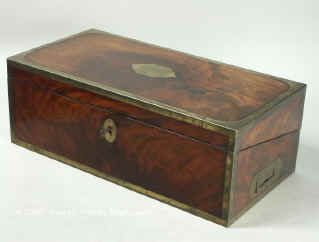
This is a
box which needs a series of WebPages to itself.
It is both a writing
and a dressing box. It has a screw-down mechanism, so that it can be secured to
the floor, or table. There is a plethora of tricks for revealing hidden sections
and secret drawers.
|
There are secret containers even in the back
sections (rare), The
part which meets in the middle when the box is opened to the writing position is
thicker to accommodate these. The secret containers fit very snuggly in very precisely crafted spaces. The side drawer is
fitted out as a dressing box. The tops of the glass jars are in silver, a most
unusual feature in boxes of combined usage.
The silver bears the crest design of a
horse in a central cartouche, an indication that it belonged to an officer of
the cavalry. It bears hallmarks for 1829. A box
of remarkable complexity and quality.

|
The brass is
structural, protective, and ornamental; it sets off the remarkable patterning
of the flame mahogany.
The brass is fitted with
brass riveting. This was innovative. Most boxes at this date have the
brass fitted with flattened iron screws.
|
Please click on images to enlarge
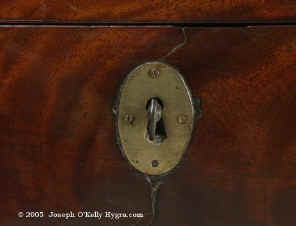
|
Close up of the escutcheon.
There are some veneer cracks which are surface and not structural. This
is not unusual when the grain figure is particularly beautiful. Overall
the box has a good patina and retains its original finish.
|
Front view: the figure of the
mahogany is exceptional.
|

|
Please click on images to enlarge
The writing surfaces have been
recovered. An embossing tool circa 1800 was used to do the
embossed edge. The color was selected to match the leather used by
Palmer in the drawer.
|
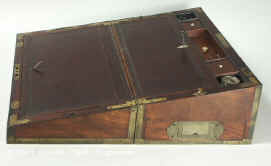
|
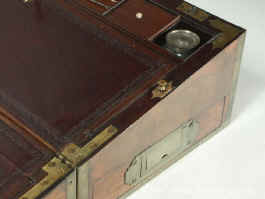
|
There is a fitted side drawer which is
secured by a pull.
The silver plate on copper inkwells
are original.
|
Please click on images to enlarge
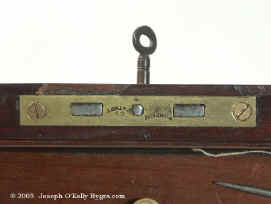
|
The lock is marked Tompson and Lambley --GR Patent.
|
The firm of LAMBLEY A & CO PORTABLE WRITING DESK
MFR LADIES' WORK CASE MFR Birmingham was active from 1800.
Both he and Tompson are in
the Wrightson's Triennial Directory for 1818
|
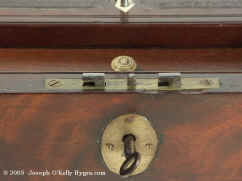
|
I
have seen the name Tompson on other box locks. I have yet to research the
patents office.
The special quality of the lock
is probably is the way the tennon can retract into the lock.
The tennon is the bit that sticks out! there is in this lock a
mechanism to countersink; I think this is probably the invention/ the special of the patent.
Some boxes of a slightly later style with rosewood veneers rather than
mahogany have an escutcheon which reads Tompsons patent: see http://www.hygra.com/wb/wbdg12.htm There
is a "Tompson, William, Patent Lock Mkr, Key Stamper, Bull St." in
the Birmingham directory for 1818.
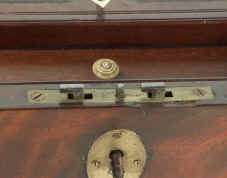
|
Here the tennons are shown in the
locked position.
also in this picture is the turned
knob of the pen compartment. The curved pen tray was introduced circa
1800.
|
Please click on images to enlarge
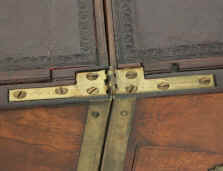
|
The hinge: the screws unusually
for the period are brass.
|
Under the flap is divided in three. The secrets are to be
revealed.
|

|
The Secrets
The lining of is slid out revealing a small hole. When a sharp object,
a steal stiletto from the necessaire drawer, the sprung pen and ink tray
lifts up.
There is a similar catch at the other end.
|
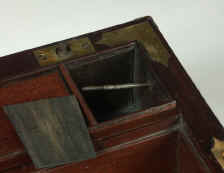
|
Please click on images to enlarge
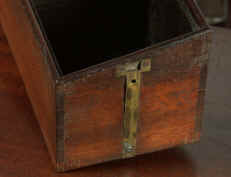
|
Detail: the end of the springable liftout pentray. It is of
fine dovetail construction. The hole in the brass is to allow the sharp
object of release through.
|

|
The liftout pentray isolated.
|
Please click on images to enlarge
There are springs to lift the pen tray. The springs are
annealed bronze. There seems to be an attempt in this box to deal
with what must have been a problem. Iron rusts.
|
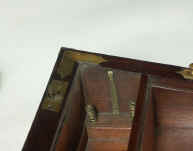
|
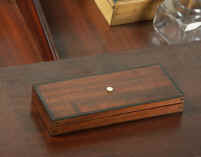
|
In the sides are revealed ebony edged boxes for the
placing of ultimate secrets.
|
Please click on images to enlarge
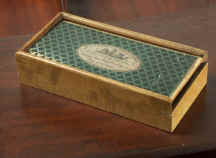
|
Another box with a Palmer label and a Royal Warrant: Palmer &
Sons, East Grinstead. Pencutter to the Royal Family.
|
Another secret: The division slides.
The wood on the side is sprung.
|
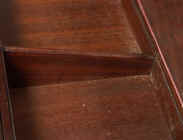
|
The divider moves. The wood
springs. To achieve this the grain direction is precise. The marks of
the movements are visible.
|

|
Please click on images to enlarge

|
And comes out revealing a lift out panel.
|
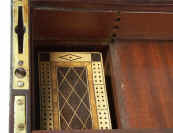
|
Underneath is an inlaid cribbage box. Is this how the
Captain maintained his revenue?
|
Please click on images to enlarge

|
There is a small hole in the
side. The stiletto tool is inserted.
|
A panel springs open, revealing two drawers.
|
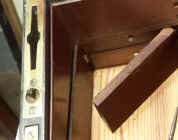
|
Please click on images to enlarge
The triangular shaped piece
of metal is the top of a screw for fixing the box to a table or floor.
|
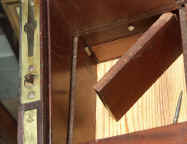
|
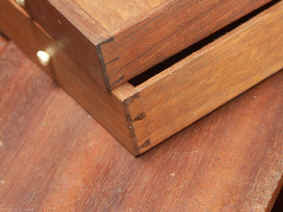
|
The drawers are of fine dovetail construction.
They are both semi blind
dovetail: they do not appear on the surface.
There is a description of
dovetails in another box at: http://www.hygra.com/wb/wbmabrstrp.htm
|
Please click on images to enlarge
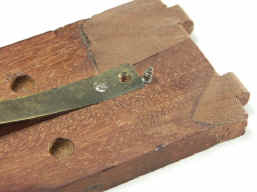
|
There are some repairs to the panel. The damage, obviously,
resulted from an attempt to break in to the secrets. for this photo one of
the screws has been taken out so that its tip is visible. the spring is
bronze.
This box is on the edge of
innovation:
It has secrets; it has
evidence of attempts to breach its secrets. It has repairs to those
attempts. It has some of the earliest brass screws I have ever seen.
This one is steel!
|
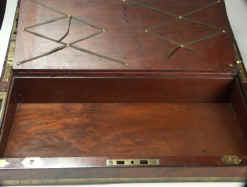
|
There are more
secret compartments in the upper part. They are hidden behind the panel. Even
on the inside beautifully grained almost landscape mahogany is used.
|
Please click on images to enlarge
The panel hiding the secret
compartments is released by
inserting a sharp object into an almost invisible hole.
|
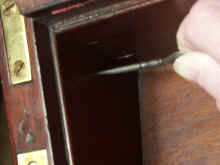
|
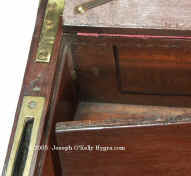
|
Detail of the catch. There
are some marks to the top of the panel which indicate that the box had a
forced entry. this is part of its history.
What is this story?
|
The piece of brass on the
panel is a little crude and probably is a repair following the forced
entry. The marks of the forced entry are visible on the panel.
|
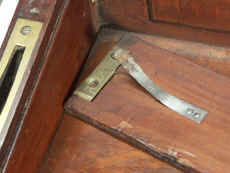
|
Behind the panel are lift out
ebony edged boxes. A new form of joint is used in these. The four sides
are mitered. But it is not possible to glue end grain to end grain with
any hope of long term success. To stabilize pieces of triangular
profiled ebony have been slid through the miter joint.
|
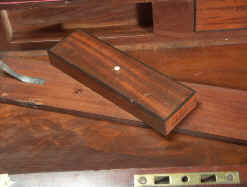
|
Please click on images to enlarge

|
There is the trace of a label
on the underside of the writing surface. I believe this was the label
of N Middleton who was at 162 Strand London in the early 19th C.
Its easier to see in the magnification.
|

|
The side drawer is fitted
with dressing accessories.
The maker's name, George
Palmer is engraved on a
brass strip inset into the inside front of the side drawer. George
Palmer, who worked in St. James's
London, was probably responsible for fitting the dressing
accessories.
He was a maker to the King and the Royal family in the early 1830s, although
it is not clear when he first attracted Royal custom.
|
Please click on images to enlarge
There are hallmarked silver
toped glass containers, razors, a boot strap puller, a foldable comb,
brushes.
|
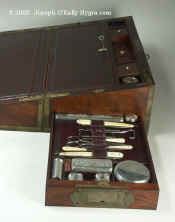
|
Please click on images to enlarge
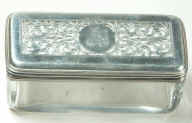
|
The silver is chased and
pierced. In a central medallion is the crest of a horse.
|

On the top is a reference to Palmers Royal warrant. "G the
crown R" This is George Rex: King.
To the very left is the "maker's" or "sponsors"
mark: A.D
The next punch is the "King's head": George III
The next mark "Lion Passant" denotes that this is silver
of sterling standard. (925)
The date letter "n" is next, indicating 1828/9 and
finally the "Leopard's head for London.
|
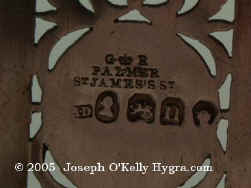
|
Please click on images to enlarge
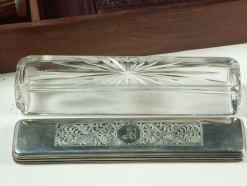
|
The glass has a
cut star motif on the base.
|
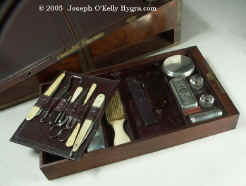
|
There are more brushes under
the tray.
|
Please click on images to enlarge
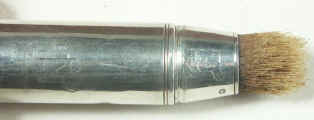
|
Each of the parts of the
foldable shaving brush is hallmarked and bears the horse crest.
|
The horse crest is also
engraved on the ivory handles of the razors.
|
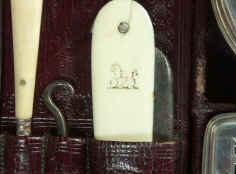
|
Please click on images to enlarge
The razors are marked
with Palmers name. One of the razors has an old been repair with a
back plate and silver rivets.
|

|
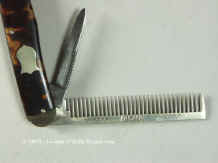
|
A combination comb and knife.
The comb is silver and hallmarked. The handle is tortoiseshell.
|
Please click on images to enlarge
Side view
|
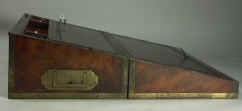
|
Please click on images to enlarge

|
A
|
All text and images and linked images are ©
1999-2004 Antigone Clarke and Joseph O'Kelly. If you require any further
information on permitted use, or a licence to republish any material, email us
at copyright@hygra.com
|
